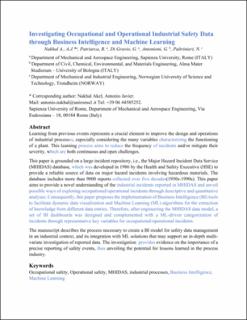| dc.contributor.author | Nakhal A, A | |
| dc.contributor.author | Patriarca, R. | |
| dc.contributor.author | Di Gravio, Gravio | |
| dc.contributor.author | Antonioni, G. | |
| dc.contributor.author | Paltrinieri, Nicola | |
| dc.date.accessioned | 2022-09-12T12:34:32Z | |
| dc.date.available | 2022-09-12T12:34:32Z | |
| dc.date.created | 2021-11-19T12:44:30Z | |
| dc.date.issued | 2021 | |
| dc.identifier.citation | Journal of Loss Prevention in the Process Industries. 2021, 73 . | en_US |
| dc.identifier.issn | 0950-4230 | |
| dc.identifier.uri | https://hdl.handle.net/11250/3017292 | |
| dc.description.abstract | Learning from previous events represents a crucial element to improve the design and operations of industrial processes, especially considering the many variables characterizing the functioning of a plant. This learning process aims to reduce the frequency of incidents and/or mitigate their severity, which are both continuous and open challenges.
This paper is grounded on a large incident repository, i.e., the Major Hazard Incident Data Service (MHIDAS) database, which was developed in 1986 by the Health and Safety Executive (HSE) to provide a reliable source of data on major hazard incidents involving hazardous materials. The database includes more than 9000 reports collected over five decades (1950s–1990s). This paper aims to provide a novel understanding of the industrial incidents reported in MHIDAS and unveil possible ways of exploring occupational/operational incidents through descriptive and quantitative analyses. Consequently, this paper proposes the implementation of Business Intelligence (BI) tools to facilitate dynamic data visualization and Machine Learning (ML) algorithms for the extraction of knowledge from different data entries. Therefore, after engineering the MHIDAS data model, a set of BI dashboards was designed and complemented with a ML-driven categorization of incidents through representative key variables for occupational/operational incidents.
The manuscript describes the process necessary to create a BI model for safety data management in an industrial context, and its integration with ML solutions that may support an in-depth multi-variate investigation of reported data. The investigation provides evidence on the importance of a precise reporting of safety events, thus unveiling the potential for lessons learned in the process industry. | en_US |
| dc.language.iso | eng | en_US |
| dc.publisher | Elsevier | en_US |
| dc.title | Investigating occupational and operational industrial safety data through Business Intelligence and Machine Learning | en_US |
| dc.type | Journal article | en_US |
| dc.type | Peer reviewed | en_US |
| dc.description.version | accepted Version | en_US |
| dc.rights.holder | This accepted manuscript will be available November 2023 due to publisher embargo | en_US |
| dc.source.pagenumber | 17 | en_US |
| dc.source.volume | 73 | en_US |
| dc.source.journal | Journal of Loss Prevention in the Process Industries | en_US |
| dc.identifier.doi | 10.1016/j.jlp.2021.104608 | |
| dc.identifier.cristin | 1956445 | |
| cristin.ispublished | true | |
| cristin.fulltext | original | |
| cristin.qualitycode | 1 | |
